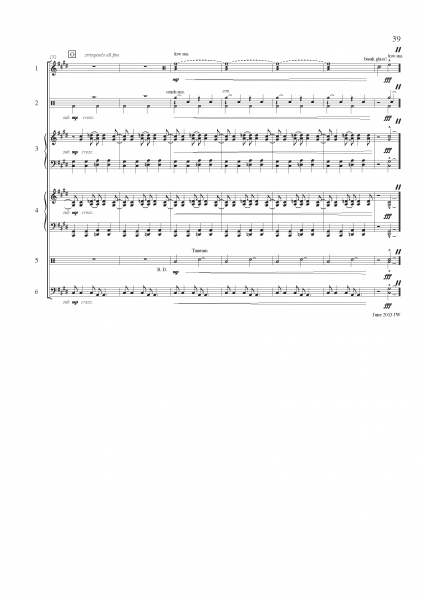JW020 Chaitanya (Percussion Emsemble von John Thrower und Jand Willems
- Artikel-Nr.: JW020
Chaitanya für 6 Percussion Players by John Thrower (1 and 3) and Jan Willems (2)
1. 9 2 5 1
2. Small Things
3. Fusion 1-6-2-5
CHAITANYA for 6 Percussion Players was written and commissioned by Jeannni Zhang for the Jianli Percussion Group in Peking. I had contact with Jeanni and after several mails he asked me for the piece. Perhaps what is interesting is the way it was composed. I told my copyist, Jan Willems, that I wanted to do the piece without computor, the very old-fashioned way, with pencil and manuscript. I had not written such a piece in over 20 years. No piano, no keyboard, just pencil and paper and your inner thoughts and ear. It was a wonderful experience for me and I am curious to hear how it sounds. This is not to say that I am necessarily against digitalisation, but if there are any composers out there reading this, all I can say is try it. You will be amazed. It is like going into deep meditation. ʻChaitanyaʼ is derived from the Sanskrit language and basically means ʻa high state of consciousness, joy and peaceʼ. The 1st movement, ʻ9251ʼ refers simply to time ideas. It is not in any way harmonically directed with the numbers, whereas the last movement, ʻFusion 6-2-5-1ʼ actually refers to a harmonic pattern in the 3rd movt. which often repeats.
The 2nd movement, ʻSmall Thingsʼ refers to the very minimal use of only a few instruments where most of the players are playing the same instruments.
The 1st and 3rd movements surround the 2nd movement also in stylistic mannerism. These movements are more in a fusion style of popular (drum-set) ideas with jazz riffs and virtuose Marimba playing. The 2nd movement is totally classical in ambient and except for the temple blocks does not demonstrate any particular harmonic developments. It should be noted that today, most symphony orchestras, at least in Germany have at least one percussionist that can play drum-set. So we do see that fusion elements have really infiltrated the traditional classical orchestra. Thus, I hope that this is acceptable also in this piece.
GENERAL CONSIDERATIONS
The main instruments are the two Marimbas. (players 4 & 5). Percussion Players 1,2, 5 and 6 should have an array of instruments where they can make an interesting improvisation (mixture of drums/metals/woods/exotic, etc.), although from the ensemble point of view, they generally stay in the areas of high, medium and low. Players 3 and 4 should have instruments for improvised sections. Most instruments are designated, whereas others are not. It is up to the ensemble to decide what is appropriate for their own ensemble. An ensemble could have several hundred instruments on stage or only 20 depending on the circumstances. There are no limitations to the amount of instruments and yet one could also be very minimal having a few choice instruments. Any and all exotic and ethnological instruments
PERFORMING CONSIDERATIONS
Each player should have some instruments (suspended metals) where fortissimo can be achieved. Stage Positioning should reflect this idea. The Marimbas in the middle of the stage. Players 1, 2 (in the middle because of the Drum-Set) and 3 spread out behind the Marimbas, elevated if possible, as in a concerto for two Marimbas with orchestra in back. Player 6 somewhat in the middle. There may be times depending on how the set-up is made where a smooth switch of instruments might be difficult. In this case experiment with mallets that might work for both instruments. Also note that such repetitive patterns that are designated for example in Drum set, may be altered if a switch is too difficult to make in time. All freedom of improvisation is up to the ensemble, even the suggested times of improvisatory sections, which may be extended or shortened. All movements may be played seperately or freely combined. The 1st and 3rd movements are classic fusion in stylistic and the middle movement, traditional classical percussion. *Break Glass. Percussion 1 and Percussion 2 have notated ʻbreak glassʼ. This is one single shatter as if a ball shattering a window pane of glass. Please decide how to do this.
































